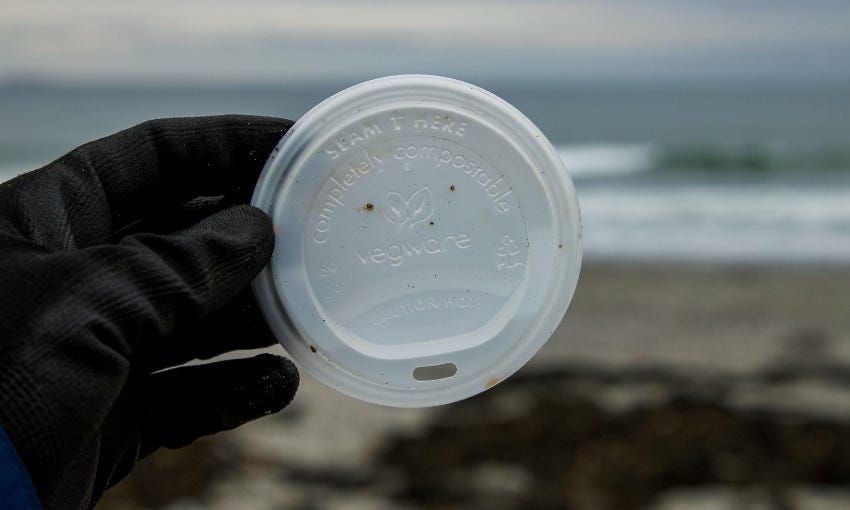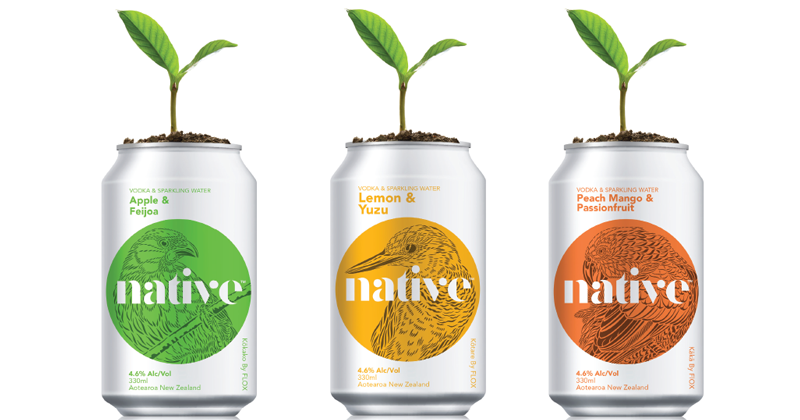Cucumbers, cow farts and the future of plastic
Meet a scientist designing the sustainable packaging of tomorrow.
Kia ora! Welcome back to Future Proof, brought to you by Electric Kiwi.
Over the summer break, I’ve been eating ice cream and thinking about ice cream tubs. My favourite brand of ice cream comes in those flexible, papery containers. They’re apparently “commercially compostable” – which sounds great… but how does the average Kiwi access a commercial composting facility, exactly? I can’t compost it at home and I can’t chuck it in the recycling. So where does it end up? Landfill.
Alec Foster understands my frustration, and says New Zealand needs to up its game when it comes to the whole life cycle of packaging – from manufacture to end-of-life disposal. Foster is the lead scientist for bioproducts and packaging at Scion Research, where researchers are designing sustainable packaging solutions.
There’s still a role for plastic
Plastic is still useful in some contexts – for example, consider the cucumber. Think of all the carbon that’s required to grow the cucumber from a tiny seed. Wasting just one cucumber is equivalent to the carbon of wrapping 83 cucumbers in plastic, Foster explains. So it’s better to use a bit of plastic to extend the shelf life of the cucumber three or fourfold.
But the difference is, in future this cucumber wrap will be bioplastic, instead of derived from planet-heating fossil fuels. Bioplastics are produced using fermentation of a range of different “feedstocks”, such as plant starches, dairy waste or even methane. “Our primary industries produce a lot of different types of waste that we could quite easily convert into packaging solutions,” says Foster. At Scion, they’re working on using methane to make a type of bioplastic called PHA. I tell Foster I’m imagining cows wearing balloon contraptions to capture their farts to make plastic. “Well, as funny as it sounds, one of my scientists proposed something not too dissimilar to that,” he replies.
Bioplastics can be composted, and some can be recycled with the right infrastructure. Scientists are figuring out ways to make bioplastics stronger and more heat resistant too. But right now, the biggest challenge for bioplastics is price – they’re usually twice as much as an oil-based plastic. “That's why we're looking at these cheaper waste streams,” says Foster.
Biodegradable vs compostable
So what does compostable actually mean? A compostable plastic will break down into carbon dioxide over time – and this is something Scion tests at its purpose-built composting facility, to check claims made by packaging manufacturers are legit. Compostable is different to “biodegradable” – a vague term Foster says is often used to greenwash. “It just means it breaks down, but it could break down into microplastics,” he says.
The Scion packaging team have recently developed a fully compostable plant pot. “Upon planting, the pot starts breaking down into carbon dioxide. Within 12 months it’s fully composted,” says Foster. It may seem minor, but people don’t really know what to do with conventional plastic plant pots. They can’t be recycled because they’re too contaminated.
The truth about recycling
"Most people think when they put their things into the recycling bin, most of it ends up getting recycled,” says Foster. “The truth is, it's only a small fraction.” Globally, less than 10% of plastic ever produced has been recycled. Of the 17.5 million tonnes of waste Kiwis produce each year, about 70% heads to landfill.
The system needs to change, and Foster would love to see New Zealand shift towards a circular bioeconomy, rather than the linear “take, make, waste” system we’ve currently got. “New Zealand should be generating the feedstocks, generating the bioplastics, and generating products with suitable end-of-life solutions,” he says.
Here’s to cucumbers with long shelf lives, cow-fart plastics, and ice cream tubs I can one day put in the kerbside compost bin.
Wanna broadband with Electric Kiwi?
Electric Kiwi want to make broadband better for all Kiwis and this means offering a fair price and providing great service, but without any contracts, notice periods or exit fees. They also believe all Kiwis deserve fairer broadband, so their daily charge means you’ll never pay for any extra days if you need to leave. from $2.65 per day and get a free Orbi Wifi 6 modem. Plus, get 2 months free Broadband if you join before the end of March. T+Cs apply.
2022 Aotearoa’s hottest year on record
Last year was yet another record-breaker – the hottest year on record since Niwa began record-keeping in 1909, Olivia Wannan reports for Stuff. It was also the warmest and wettest winter on record, with one Niwa weather forecaster describing 2022’s short, sharp downpours as “binge rainfall”. But 2023 could bring drier weather to Aotearoa as we shift into El Niño, Jamie Morton reports for the Herald (paywall), heightening wildfire and drought risk on the east coast. But the wild wet weather might not be over just yet: after the climate change-fuelled chaos of Cyclone Hale, a second regional cyclone might form next week.
And it’s hot in the oceans too
2022 was the hottest year on record for ocean temperatures, a new global analysis finds. More than 90% of the heating caused by greenhouse gas emissions is absorbed by the ocean, and last year an extra 10 zettajoules of energy was pumped into the system compared to 2021. That’s equivalent to every person on Earth running 40 hairdryers all day, every day. Meanwhile, the lower South Island is currently experiencing an extreme marine heatwave. Surface waters off Haast are currently measuring 23 degrees – a temperature you’d normally see in Northland.
Helping the planet has never tasted so delicious
Connecting New Zealanders’ love for good times with our passion for the planet, Native Sparkling is a local drinks company with a future-focused mission. Every 4 x 10pks sold supports the planting of another native tree, to help native species thrive and improve biodiversity in Aotearoa - starting on their family farm in the Manawatū. A naturally refreshing summer drop, Native Sparkling is made with real fruit, sparkling water and premium plant-based vodka. Find out more about Native's mission. (Sponsored)
Ozone hole will be fully healed in decades
A 1987 global agreement to stop using ozone-destroying chemicals has proved successful, according to a UN report, which estimates the Antarctic hole will be plugged by 2066. This success “sets a precedent for climate action,” the World Meteorological Organization says. Kelsey Piper traces the story of the ozone hole, and humanity’s response, in this long read on Vox.
What does 30x30 actually mean?
Just before Christmas, 200-odd countries at the Cop15 biodiversity summit reached a “breakthrough” deal for nature. The jewel in this negotiated crown is the 30x30 target, which calls for 30% of land and 30% of seas to be protected by 2030. But what does this actually look like in practice? Grist’s Blanca Begert examines how some decision makers are grappling with the complexity.
More stories:
Stuff’s Olivia Wannan fact-checks the claim that Kiwi farmers are the most carbon efficient food producers in the world, while Nikki MacDonald checks in on the progress of trials to test whether a red seaweed supplement can cut cows’ methane emissions.
The violent eruption of Hunga Tonga-Hunga Ha’apai is a wake-up call to keep an eye on other submarine volcanoes, Professor Shane Cronin writes in The Conversation.
To avoid climate breakdown, we need to radically reduce our consumption of resources, Catherine Knight writes on The Spinoff. (A great follow-up read to our edition on degrowth from last month).
Want to feed your backyard birds? Here’s what you need to know.
Newsroom’s Marc Daalder scans ahead to see what’s in store for climate policy in this election year.
Meet the new COP28 president. He’s the chief executive of an oil company.
Maia Ingoe has never seen a Māui dolphin, but saving the species still matters to her, she writes on The Spinoff. A moving love letter to New Zealand’s tiniest dolphin.
Left: the new gecko, te mokomoko a Tohu. Right: Duvaucel’s gecko. Image credit: Nick Harker (CC BY-SA 4.0).
New gecko just dropped! Researchers have described a new gecko species hiding in plain sight. Meet te mokomoko a Tohu, who lives on a handful of rocky islands in Cook Strait and is critically endangered. The researchers say, “We cannot hope to stop extinctions if we don’t know what’s out there. This is why taxonomy, which is critically underfunded in Aotearoa, is so important.”
All the best for a 2023 that tips the ~scales~ in favour of the climate, people and geckos!
Ellen
Got some feedback about Future Proof or topics you’d like covered? Get in touch with me at futureproof@thespinoff.co.nz















